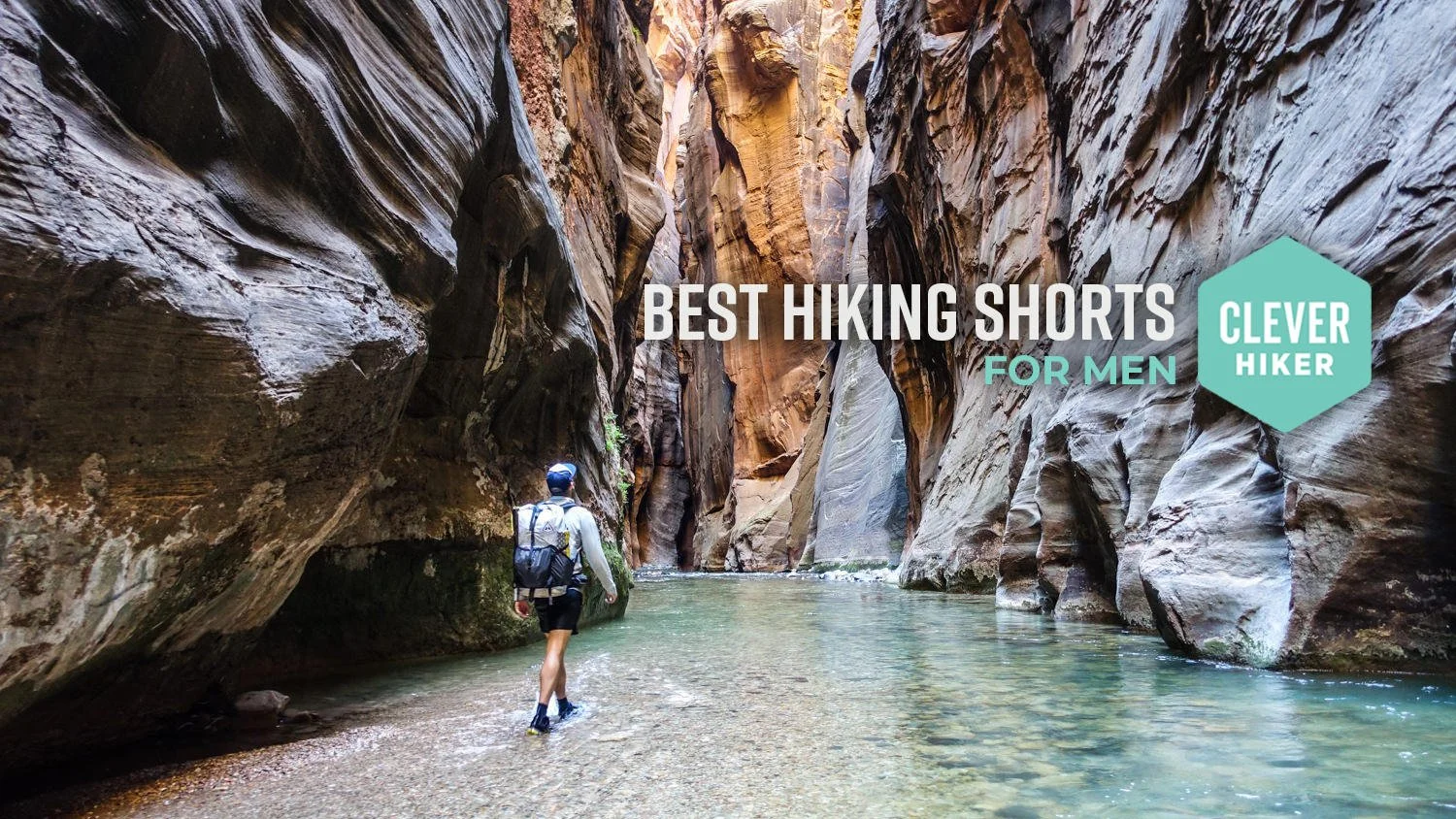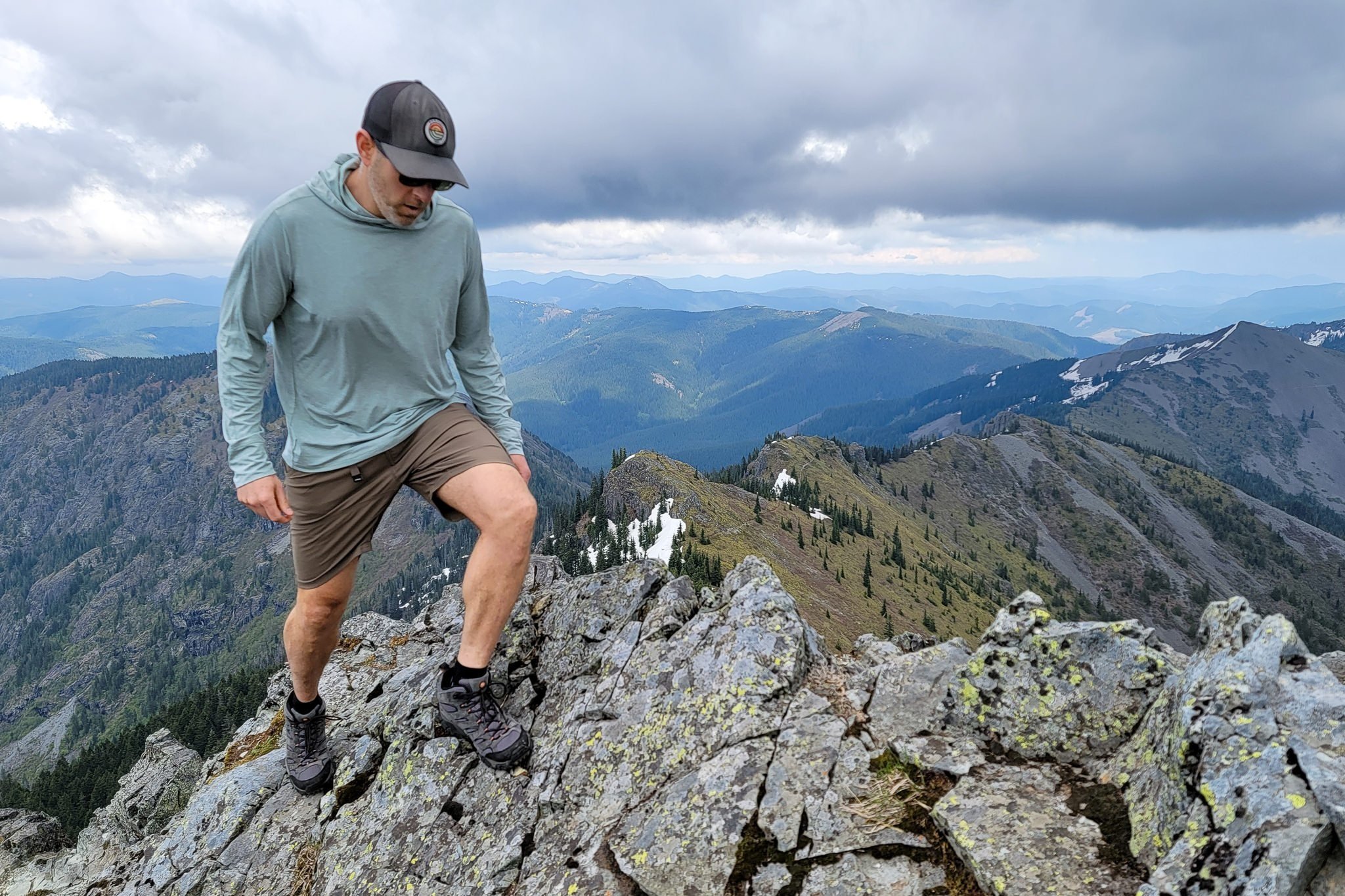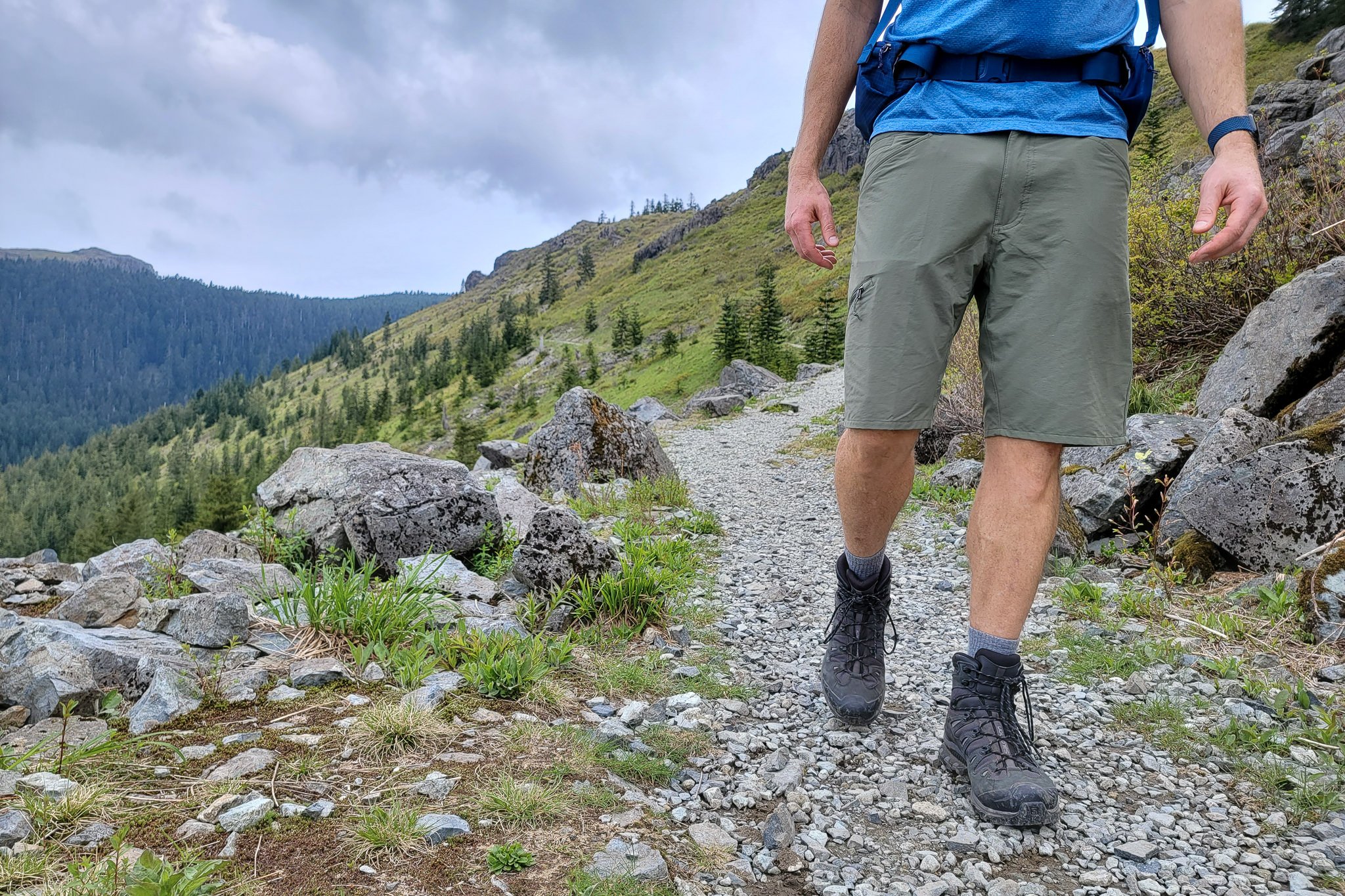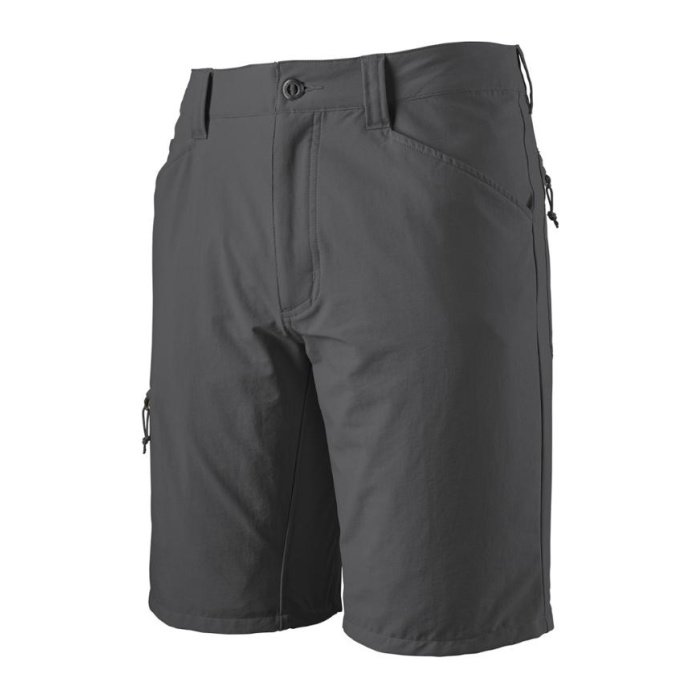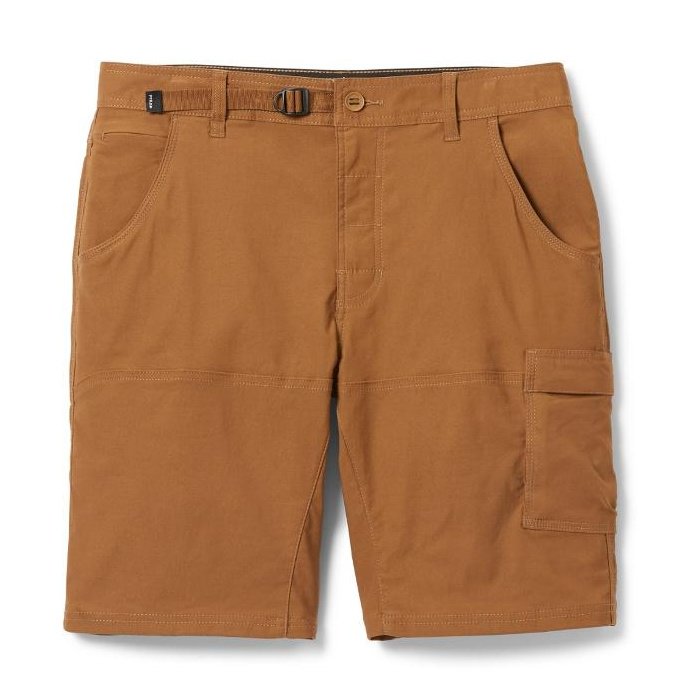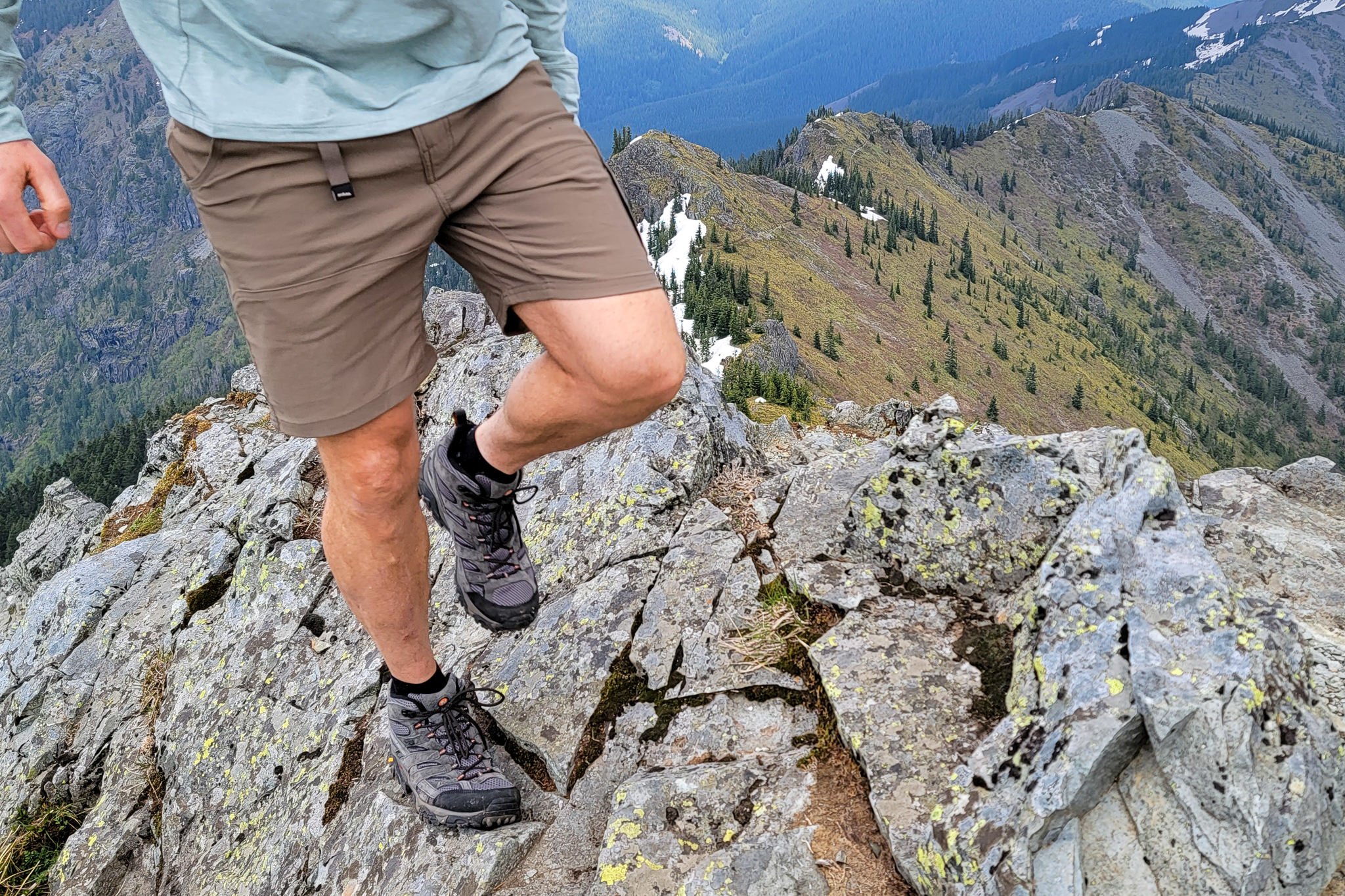We prefer to hike in shorts for most of our adventures since they make it easier to stay cool and allow for a full range of movement.
The CleverHiker team has worn dozens of different shorts on hikes all over the world, so it’s safe to say we’ve become experts on the subject over the years. Read on to find your new favorite pair of hiking shorts.
Related: Best Hiking Shorts for Women
The prAna Stretch Zion II are an excellent value because they’re durable, easy to move in & versatile
Quick Recommendations
Check out this quick list of our favorite hiking shorts if you’re in a hurry, or continue scrolling to see our full list with in-depth reviews.
Best hiking shorts overall: Patagonia Quandary
Best athletic shorts for hiking: Nike Dri-FIT Challenger
Best value hiking shorts: prAna Stretch Zion II
Best balance of durability, utility & style: Outdoor Research Ferrosi
Best town-to-trail shorts: prAna Brion II
Best budget hiking shorts: Columbia Silver Ridge Cargo
Stylish & versatile athletic shorts: Vuori Kore
Athletic shorts with secure hand pockets: Patagonia Nine Trails
Quick drying cross between board shorts & hiking shorts: REI Trailmade Amphib
Affordable hiking shorts with a flat waistband: The North Face Wander
We’ve worn the Nike Dri-FIT Challenger shorts for years because they’re comfy, ultralight & they dry quickly
What’s Most Important to You in a Pair of Hiking Shorts?
PRICE - We think it’s worth spending a bit more on high-quality clothing that you plan to wear a lot. Comfort, durability, and a well-designed fit usually trump cost in our books, but we recommend quality options for every budget below.
Best value hiking shorts: Patagonia Quandary, prAna Stretch Zion II & Vuori Kore
Best budget hiking shorts: Nike Dri-FIT Challenger, Columbia Silver Ridge Cargo, REI Trailmade Amphib & The North Face Wander
Best high-end hiking shorts: prAna Brion II & Outdoor Research Ferrosi
The value-priced Patagonia Quandary shorts will last through many seasons of tough hiking
WEIGHT - We look for lightweight clothing that’s easy to move in, breathes well, and dries quickly for most of our hikes. But heavier shorts may be the better choice for long-term durability.
Best ultralight hiking shorts: Nike Dri-FIT Challenger & The North Face Wander
Best lightweight hiking shorts: Patagonia Quandary, Patagonia Nine Trails & REI Trailmade Amphib
Best heavy-duty hiking shorts: prAna Stretch Zion II, prAna Brion II & Columbia Silver Ridge Cargo
We tend to prefer ultralight shorts, like the Nike Dri-FIT Challengers, because they’re easy to move & stay cool in
STYLE - Some folks like shorts with a plethora of useful pockets, some look for a pair that transitions well from town to trail, and others want a minimal pair that’s light and airy. The style you choose will ultimately come down to personal preference. These are our favorites in each category.
Best athletic hiking shorts: Nike Dri-FIT Challenger, Vuori Kore, Patagonia Nine Trails & The North Face Wander
Hiking shorts with the best cargo pockets: prAna Stretch Zion II & Columbia Silver Ridge Cargo
Hiking shorts that transition well from town to trail: Patagonia Quandary, Outdoor Research Ferrosi, prAna Brion II & REI Trailmade Amphib
The stylish Outdoor Research Ferrosi shorts are just as great on trail as they are for a weekend lunch hang
INCLUSIVE SIZING - Everyone should have high performance clothing options that make them look and feel great. After all, the outdoors is there for people of all shapes and sizes!
Hiking shorts with inclusive sizing: Nike DRI-Fit Challenger, Outdoor Research Ferrosi, Columbia Silver Ridge Cargo, Vuori Kore & REI Trailmade Amphib
Best Hiking Shorts of 2023
BEST HIKING SHORTS OVERALL
MSRP: $79
WEIGHT: 7.2 oz.
IN-SEAM: 10 in.
PROS: Durable, good value, breathable, great pockets, stretchy, stylish, lightweight, versatile
CONS: A bit tight in the thigh
BOTTOM LINE: The Patagonia Quandary Shorts are an awesome value with a great balance of low weight and durability. These classic shorts are some of our favorites for day hiking since they have a nice town-to-trail look. And the breathable, stretchy fabric is also great for long-term comfort and mobility on backpacking trips. The Quandaries have a plethora of pockets, but they all sit flat and make these shorts feel very sleek for the amount of storage. For those wanting a versatile pair of shorts that can take you from urban to alpine, the Quandaries are hard to beat.
BEST ATHLETIC SHORTS FOR HIKING
MSRP: $40
WEIGHT: 4.8 oz.
PROS: Affordable, dries quickly, soft/comfy fabric, breathable, built-in liner, ultralight, inclusive sizing
CONS: Not as versatile as some
BOTTOM LINE: Hiking can be quite the workout, so we often opt to wear athletic shorts on the trail. The Nike Dri-FIT Challengers have been our go-to for many years since they're affordable, lightweight, breathable, and quick drying. The simple design makes them easy to move in, and we’ve found the ultralight material they’re made from to be very durable. For more casual day hikes, we’d probably choose something like the Patagonia Quandaries above. But for challenging hikes and longer distances, the Challengers are what we wear.
BEST VALUE HIKING SHORTS
MSRP: $75
WEIGHT: 9.7 oz.
PROS: Very durable, great value, stretchy, stylish, built-in belt, versatile
CONS: A bit heavy
BOTTOM LINE: prAna clothing is known for having a great balance of style and longevity, and the Stretch Zion II shorts certainly live up to that reputation. The fabric is stretchy, easy to move in, and thick yet breathable for durability and comfort. The Zions are a bit on the heavy side, so we like the trimmed down design of the prAna Brions (below) for most casual outings. But those going for utility will like that the Zions offer a ton of secure storage without feeling or looking frumpy like some other cargo shorts. These crowd-favorites are an awesome value since they’re comfortable, they have a built-in belt for dialing in the fit on long hikes, and they can be worn for pretty much any occasion.
BEST BALANCE OF DURABILITY, UTILITY & STYLE
MSRP: $79
WEIGHT: 7.6 oz.
PROS: Stretchy, breathable, durable, good pockets, versatile, dries quickly, 7 in. shorts include belt, stylish, inclusive sizing
CONS: Expensive
BOTTOM LINE: We love the Ferrosi Pants from Outdoor Research, so we had high hopes for the Ferrosi Shorts - and they didn’t disappoint! They have deep, useful pockets, a nice built-in belt, and plenty of stretch for a full range of movement. We find the look and fit to be comfortable on trail as well as stylish enough for around town use, so these versatile shorts are ready for any adventure. Whether you’re going for a quick jaunt in a city park or setting off for a thru hike, the breathable and durable Ferrosis are a great choice.
BEST TOWN-TO-TRAIL SHORTS
MSRP: $75
WEIGHT: 8.6 oz.
PROS: Stylish, stretchy, durable
CONS: Expensive, not as good for longer backpacking trips (not as many pockets, fit is a bit tighter)
BOTTOM LINE: We own several pairs of the prAna Brion shorts and have been rocking them for years because we love their town-to-trail style. With a simplified pocket setup and a more flattering fit, the Brions are a trimmed down version of the iconic prAna Stretch Zions above. We highly recommend these for day hikes and frontcountry camping, but something with more pockets and a looser fit, like the Stretch Zions or Patagonia Quandaries, may be better for backpacking. That said, the Brions have a good amount of stretch to balance out their slim fit, and they’re ready for any adventure if you prefer more minimalist bottoms.
BEST BUDGET HIKING SHORTS
MSRP: $50
WEIGHT: 10.4 oz.
PROS: Affordable, breathable, town-to-trail look, good pockets, includes belt, inclusive sizing
CONS: Not as durable as some, a bit heavy
BOTTOM LINE: Cargo shorts have a tendency to look bulky, but the affordable Columbia Silver Ridge Cargo are a trimmed down take on utilitarian bottoms. These stylish shorts have a secure pocket on each thigh that we find really useful for storing important small items, like a key or an ID. But the lightweight fabric isn’t very durable compared to some others, and the pockets will typically be the first thing to show signs of wear. That said, we think the weight tradeoff is worth the small durability penalty since the Silver Ridges don’t feel as frumpy as some other cargo shorts we’ve worn.
STYLISH & VERSATILE ATHLETIC SHORTS
MSRP: $68
WEIGHT: 7.7 oz.
PROS: Stylish for athletic shorts, built-in liner, very soft & comfortable, dries quickly, stretchy, versatile, inclusive sizing
CONS: Boxer brief liner can bunch up
BOTTOM LINE: The Vuori Kore shorts are versatile bottoms that we use for anything from swimming, to day hikes, to casual outings around town. They’re pretty good lookin’ for athletic shorts and comfier than dedicated hiking shorts (like the prAna Stretch Zions), so they’re a good in-between when the occasion calls for a balance of performance and style. We prefer the Nike Challengers above for longer hikes because they have a brief liner; the boxer briefs of the Kore shorts can have a tendency to ride up. That said, the Kores are some of our favorites for shorter hikes and urban walks.
ATHLETIC HIKING SHORTS WITH SECURE HAND POCKETS
MSRP: $75
WEIGHT: 6.4 oz.
INSEAM: 8 in.
PROS: Stretchy, dries quickly, breathable, great hand pockets for athletic shorts, lightweight, built-in liner
CONS: Not as durable
BOTTOM LINE: The Patagonia Nine Trails are a close second to our go-to athletic shorts, the Nike Dri-FIT Challengers above. We ranked the Nikes higher for their friendlier price point, more functional brief liner, and wider range of size offerings, but where the Nine Trails win out is in their more flattering fit and the inclusion of zippers on the hand pockets. The Nine Trails are less billowy, but still plenty breathable and airy for toasty days on trail. The lightweight material of the Nine Trails is a little thin, so they may not be the best choice for trails that include a lot of butt-scooting down rock. But we think the tradeoff in durability is worth it for the soft, comfy fabric and non-cumbersome fit.
QUICK DRYING CROSS BETWEEN BOARD SHORTS & HIKING SHORTS
MSRP: $50
WEIGHT: 6 oz.
INSEAM: 6 in.
PROS: Dries quickly, affordable, lightweight, stylish, inclusive sizing
CONS: Not stretchy, included belt is low quality
BOTTOM LINE: The REI Trailmade Amphib shorts are versatile bottoms that sit somewhere between board shorts, hiking shorts, and casual everyday shorts. These amphibious shorts are perfect for those who never miss a chance to dip into a lake on trail, as they’ll be dry shortly after you resume hiking. The Amphibs are very similar to the popular Patagonia Baggies (in Honorable Mentions below), but these are a bit more affordable, they come with a built-in belt, and the fabric feels a little softer than the Baggies. The Amphibs are nice looking, but since they’re not stretchy we typically only use them for short, easy hikes.
AFFORDABLE HIKING SHORTS WITH A FLAT WAISTBAND
MSRP: $50
WEIGHT: 4.4 oz.
INSEAM: 7 in.
PROS: Affordable, flat waistband sits nicely under a hipbelt, ultralight, dries quickly
CONS: Fabric is swishy & stiff, no way to cinch the waist
BOTTOM LINE: The affordable Wander Shorts from The North Face are minimalist bottoms that fall somewhere between an athletic short and a casual short. We found the flat waistband of the Wanders to be one of the most comfy under a hipbelt, and the simple pocket setup (just two hand pockets) keep the legs bulk-free as well. We just wish the Wanders were made with a softer fabric, because the stiff polyester has a tendency to bunch up a bit. That said, we still find these shorts to be exceptionally comfortable, and we even lounge around in them at home.
The stretchy prAna Brion II shorts are great for challenging hikes
Honorable Mentions
The following hiking shorts didn’t make our final list, but they’ve still got a lot of good things going for them. You never know, a pair of these shorts might be perfect for you:
REI Sahara Cargo - Affordable cargo shorts with secure, expandable pockets. We prefer the Columbia Silver Ridge Cargo Shorts for their lower price, less bulky look, and included belt.
Baleaf Running Shorts - Comfortable and affordable running shorts with hand pockets. We prefer the Nike Challenger Shorts for their increased durability and better fit.
Patagonia Baggies - Very similar to the REI Trailmade Amphib above - the Baggies are quick drying board short/hiking short crossovers with a stylish look. Many people, us included, have reported having trouble with the fit of these shorts due to the lack of stretch.
prAna's Stretch Zion II are some of the most popular hiking shorts due to their durability & comfort
Shorts Vs. Pants
Shorts - Hiking shorts are lightweight, cool, and comfortable which is why they’re our first choice for fairweather adventures. For colder months, diehard shorts fans can add a good set of base layer bottoms to their layering system to stay toasty.
That said, shorts will leave your skin vulnerable to hazards like scrapes, sunburn, and mosquitoes. Most shorts don’t have as many pockets for storing things either.
We hike in shorts for most of our backpacking trips because we find it easier to stay comfy & cool all day
Pants - Hiking pants offer the most protection from the elements, bugs, and spiky/stinging plants. If you’re hiking in an area with thick brush or where the threat of pests such as ticks is increased, pants are probably the better choice.
Of course there are some downsides - it’s harder to regulate your body temperature in pants, they’re heavier, and they can limit your movement a bit more than shorts. Convertible and roll-up pants give you more control over temperature; we tend to prefer roll-ups for their more flattering fit. Check out our Best Hiking Pants list to see our top picks.
The Arcteryx Lefroy pants are some of our favorites from our Best Hiking Pants list
Critical Hiking Shorts Considerations
FABRICS MATTER - Synthetic materials are great for outdoor clothing since they’re durable and don’t absorb moisture. We prefer shorts made with stretchy fabrics to allow for easy movement.
Nylon - Nylon is an exceptionally durable synthetic fabric that dries quickly. It tends to feel slightly softer on the skin than other synthetic fabrics. Because of the way nylon is made, it tends to be a bit pricier.
Polyester - Polyester is very durable (although slightly less so than nylon) and naturally hydrophobic. It absorbs less water than nylon and wicks moisture more effectively. It’s also less prone to pilling, so it will stay looking nice for longer.
Cotton - Cotton is soft and comfortable, but it absorbs water. It dries very slowly, sticks to the skin and causes chafing when wet, and can be potentially dangerous in cold/wet climates. Because of these downsides, cotton is generally not recommended for outdoor activities.
Spandex/elastane - We prefer hiking shorts with some spandex/elastane content for mobility. Most shorts we tested have two-way stretch, which means they stretch in one direction (typically crosswise). Some have four-way stretch, which means the fabric stretches crosswise and lengthwise. Four-way stretch is usually more expensive, but it’s more comfortable and provides a greater range of motion.
We prefer shorts with some stretch, like the prAna Stretch Zion II, for mobility
POCKETS -We tend not to use most of the pockets on hiking shorts because items stored in them can feel bothersome and can impede movement. We prefer shorts with minimal pockets, because they look more sleek and feel more comfortable.
Back pockets - We almost never use back pockets on trail because they’re hard to access with a backpack on, and things stored there get in the way when we want to sit down.
Front pockets - Front pockets can be useful around town, but we rarely use them on trail because they’re hard to access with a hip belt on. Items stored in front pockets can also be uncomfortable when you have to lift your legs high for scrambling.
Leg pockets - Zippered pockets on the thigh tend to be the most useful in our opinion. We’ll keep small items like chapstick, a lighter, or a little multitool in there for quick access.
We don’t typically store much other than a pocket knife in leg pockets while we’re hiking
Technical Fabric Care
PRETREATED FABRICS/ MAINTENANCE - Some technical clothing comes pretreated with water or bug repellent. These pretreatments aren’t permanent, and they up the cost. You can easily maintain a treatment or add one to your shorts with these products:
Water repellency - To maintain or add water resistance to hiking shorts we recommend using Nikwax Softshell Proof. This treatment will maintain breathability while effectively causing water to bead and roll off the fabric. Keep in mind that this won’t make your shorts completely waterproof, since moisture can still get through the seams.
Bug-proofing - To maintain or add bug repellant to your clothing we recommend Sawyer Permethrin Pump Spray. It repels and kills ticks, mosquitoes, mites, and chiggers. It lasts about six weeks or six washes before you need to reapply it.
Repairing tears/holes - To patch holes and tears, we recommend using the Noso Patchdazzle Gear Repair Kit. These patches don’t require any sewing or ironing, can withstand repeated machine washes, and are UV protective and waterproof.
GENERAL CARE - Technical fabrics require some special care to keep them performing their best for years. Always follow the washing directions on the tags carefully, but we outline some general tips below:
Use a front loading washer - The agitator in a top loading washer can be hard on seams and can snag zippers or drawstrings. Make sure you zip all the zippers and tie the drawstrings before washing in a front loader to prevent wear and tear.
Use a technical fabric wash - We recommend Nikwax Tech Wash for washing any technical fabrics. You can also use a gentle detergent, like Woolite.
Only wash when you really need to - A lot of technical fabrics are designed to be antimicrobial and shouldn’t hold odors. Hiking clothing doesn’t necessarily need to be washed after every trip. Try airing your clothing out first to see if that does the trick before washing.
Don’t use fabric softener or dryer sheets - Fabric softener and dryer sheets can deposit residue on the fabric and affect the overall performance.
Hang dry when possible - Heat and agitation in the dryer can damage technical fabrics.
We recommend Nikwax Tech Wash or Woolite for washing technical fabrics
Need More Gear Advice?
If you liked this list, you’ll love the CleverHiker Gear Guide where we test and recommend tons of outdoor adventure gear from a variety of categories. here are some links to popular articles:
WHY TRUST US?
We fully understand how tough it is to find trustworthy gear advice, and that’s one of the main reasons we built CleverHiker. We live for outdoor adventure, and we take these guides very seriously. Here are some of the reasons you can trust us:
Our choices are completely independent and based on personal experience.
We’ve logged over 10,000 trail miles and test outdoor gear for a living.
We own and field test every product we recommend, which is sadly not the norm.
We travel to industry trade shows to learn about upcoming product innovations.
We constantly update our guides when new products launch.
We treat our recommendations as if they were for our family and friends.
We’re lifelong learners and we’re always open to constructive criticism. If you think we’ve missed a product or got something wrong, we’d love to hear your feedback.
We own and use all of the hiking shorts we recommend
More Information
We hope this guide helps you find the perfect gear for your needs. If you have more questions or a suggestion, we’d love to hear from you! Sign up for our newsletter to stay updated on our latest posts then visit our Facebook page and Instagram to join the community conversation.
If you found this guide helpful, please share on social media and click the little heart button below to give us a digital high five! Also, be sure to check out our CleverHiker Gear Guide to see all of our top gear picks.
Thanks for reading and happy trails!
Some of the links on this page are affiliate links, which means we may receive a modest commission if purchases are made through those links. This adds no cost to our readers and helps us keep our site up and running. Our reputation is our most important asset, which is why we only provide completely honest and unbiased recommendations.

